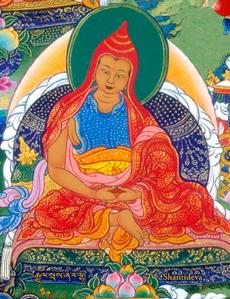Bodhicharyavatara

Bodhicharyavatara or Bodhisattvacharyavatara (Tib. chöjuk; wyl. spyod 'jug) Introduction to the Bodhisattva's Way of Life - Shantideva's classic guide to the mahayana path.
Overview
Patrul Rinpoche said that this text can be explained according to the following prayer for bodhicitta:
- O precious, sublime bodhicitta:
- May it arise in those in whom it has not arisen;
- May it never decline where it has arisen;
- May it go on increasing, further and further!
According to this view, the whole text of this book can be divided into four sections, as expressed in this prayer.
- The first three chapters (1, 2 and 3) explain how to generate bodhicitta, how to make it arise.
- The next three chapters (4, 5 and 6) explain how to prevent bodhichitta from decreasing or being dissipated.
- The next three chapters (7, 8 and 9) explain how to make the bodhichitta increase further and further.
- The 10th chapter is a concluding prayer of dedication.
Rongtön Sheja Kunrig said:
- In the beginning, the foundation is laid through the generation of the two kinds of bodhichitta. Then the text explains the six paramitas or transcendent perfections, which constitute the training in the bodhichitta in action. Finally, any merit that has been gained is dedicated towards enlightenment, as presented in the tenth chapter.
Tsoknyi Rinpoche said:
- The Bodhicharyavatara teaches the complete Mahayana path to enlightenment, including all necessary preliminary, main, and concluding practices. A perfect path in itself, it is also at the same time a perfect support for all practitioners of the Vajrayana teachings in general. Practitioners learn how to develop the motivation of bodhichitta, as well as how to carry out the application of the six transcendental perfections. They learn how to fuse their practice of bodhichitta and the five first perfections with the sixth perfection, transcendental knowledge.[1]
Outline by Chapter
The text has ten chapters:
- The Excellence of Bodhichitta
- Confession
- Commitment/Full Acceptance
- Carefulness/Conscientiousness
- Vigilance/Awareness
- Patience
- Diligence
- Meditation
- Wisdom
- Dedication
The Tibetan Translation
The Bodhicharyavatara was first translated by Kawa Paltsek and Sarvajñadeva in the early ninth century. This translation was then revised twice, first by Rinchen Zangpo, Shakya Lodro and Dharmashribhadra in the tenth century, and then by Ngok Loden Sherab and Sumatikirti in the eleventh century.
Translations in European Languages
English
- The Way of the Bodhisattva: A Translation of the Bodhicharyavatara, translated by the Padmakara Translation Group, Shambhala Publications, 2003, ISBN: 1590300572
- A Guide to the Bodhisattva Way of Life, translated by Vesna and Alan Wallace, Snow Lion Publications, 1997, ISBN: 1559390611
- A Guide to the Bodhisattva’s Way of Life, translated by Stephen Batchelor, LTWA, ISBN: 8185102597
French
- La Marche vers l’Éveil, translated by the Padmakara translation group using L. Finot's translation as a basis, Éditions Padmakara, 1992, ISBN : 2-906949-03-5
- Vivre en héros pour l'Éveil ; Bodhisattvacharyavatara, translated by G. Driessens, Édition Le Seuil—Points Sagesses 1993, ISBN : 2020196638
- La Marche à la Lumière. Poème sanscrit de Çantideva, translated by L. Finot, Ed. Brossard, 1920, re-edited by Les Deux Océans, 1987
- Bodhicaryâvatâra : Introduction à la pratique des futurs Buddhas, translated by L. de La Vallée Poussin, Louvain, 1907
German
- Shantideva, Anleitungen auf dem Weg zur Glückseligkeit / Bodhicaryavatara, O.W. Barth Verlag 2005.
- Shantideva, Die Lebensführung im Geiste der Erleuchtung / Das Bodhicaryavatara, Theseus 2004.
- Ernst Steinkellner: Eintritt in das Leben zur Erleuchtung, München: Eugen Diederichs Verlag 1981
Important Tibetan Commentaries
Many great masters and scholars of Tibet wrote commentaries on the Bodhicharyavatara, and many of these commentaries were and still are used in monastic universities in Tibet, India, Nepal, Bhutan, Sikkim, and Ladakh.
A selection of some of the more famous commentators follows:
- Sönam Tsemo (1142-1182)
- Lhopa Kunkhyen Rinchen Pal
- Ngülchu Thogme Zangpo (1295-1369)
- Butön Rinchen Drup (1290-1364)
- Lama Dampa Sönam Gyaltsen Pal Zangpo (1312-1375)
- Sazang Mati Penchen Jamyang Lodro (1294-1376)
- Tsongkhapa Lobzang Drakpa (1357-1419)
- Gyaltsab Darma Rinchen (1364-1432)
- Pawo Tsuglak Trengwa (1504-1566)
- Drukpa Pema Karpo (1527-1592)
- Mipham Rinpoche (1846-1912)
- Khenpo Shenga (1871-1927)
- Thubten Chökyi Drakpa (1823-1905)
- Khenpo Kunpal (1862-1943)
- Shechen Gyaltsap Gyurme Pema Namgyal (1871-1926)
- Lodrö Gyaltsen
English Translations of Tibetan Commentaries
- Wisdom: Two Buddhist Commentaries, Khenchen Kunzang Palden and Minyak Kunzang Sönam, translated by Padmakara Translation Group, 1993, 2nd edition 1999
- Drops of Nectar: Khenpo Kunpal’s Commentary on Shantideva’s Entering the Conduct of the Bodhisattvas, translated by Andreas Kretschmar, http://www.kunpal.com/ (chapters 1-5 only)
- The Nectar of Manjushri's Speech: A Detailed Commentary on Shantideva's Way of the Bodhisattva, by Kunzang Pelden, translated by Padmakara Translation Group, Shambhala Publications, November 2007
Contemporary Commentaries
- A Flash of Lightning in the Dark of Night: A Guide to the Bodhisattva’s Way of Life, HH the Dalai Lama, Shambhala, 1994, ISBN: 0877739714
- Anger: The Seven Deadly Sins, Robert Thurman, Oxford University Press, 2006 (A commentary on chapter 6)
- Healing Anger, The Power of Patience from a Buddhist Perspective, The Dalai Lama, Snow Lion, 1997 (A commentary on chapter 6)
- No Time to Lose: A Timely Guide to the Way of the Bodhisattva, Pema Chödrön, Shambhala, 2005
- Practicing Wisdom, The Dalai Lama, Wisdom, 2004 (A commentary on chapter 9)
- The Way of Awakening, Geshe Yeshe Tobden, Wisdom, 2005
Teachings on the Bodhicharyavatara at Rigpa Centers
- Ringu Tulku Rinpoche, Rigpa Centres worldwide, 1997-2001
- Dzigar Kongtrul Rinpoche, Lerab Ling, 2-17 June 2001 (Ninth chapter only)
- Khenpo Sönam Tobden, Pharping, Rigpa Shedra East, 2006-7 (MP3 audio files available)
Internal Links
- Questions on the Bodhicharyavatara - A simple way to test your knowledge of the text.
External Links
- Bodhicharyavatara Series on Lotsawa House
- Khenpo Kunpal's commentary The first five chapters translated by Andreas Kretschmar and available for free download in pdf format
Notes
- ↑ Drops of Nectar, Khenpo Kunpal's commentary on Shantideva's Entering the Conduct of the Bodhisattvas, translated by Andreas Kretschmar.